Anker Solix C1000 power station (check the price on the Anker website) delivers a powerful combination of fast charging, versatile ports, and a compact, travel-friendly design. It stands out as one of the top-performing power stations we’ve reviewed. Discover what sets it apart and explore the key takeaways from our full review.
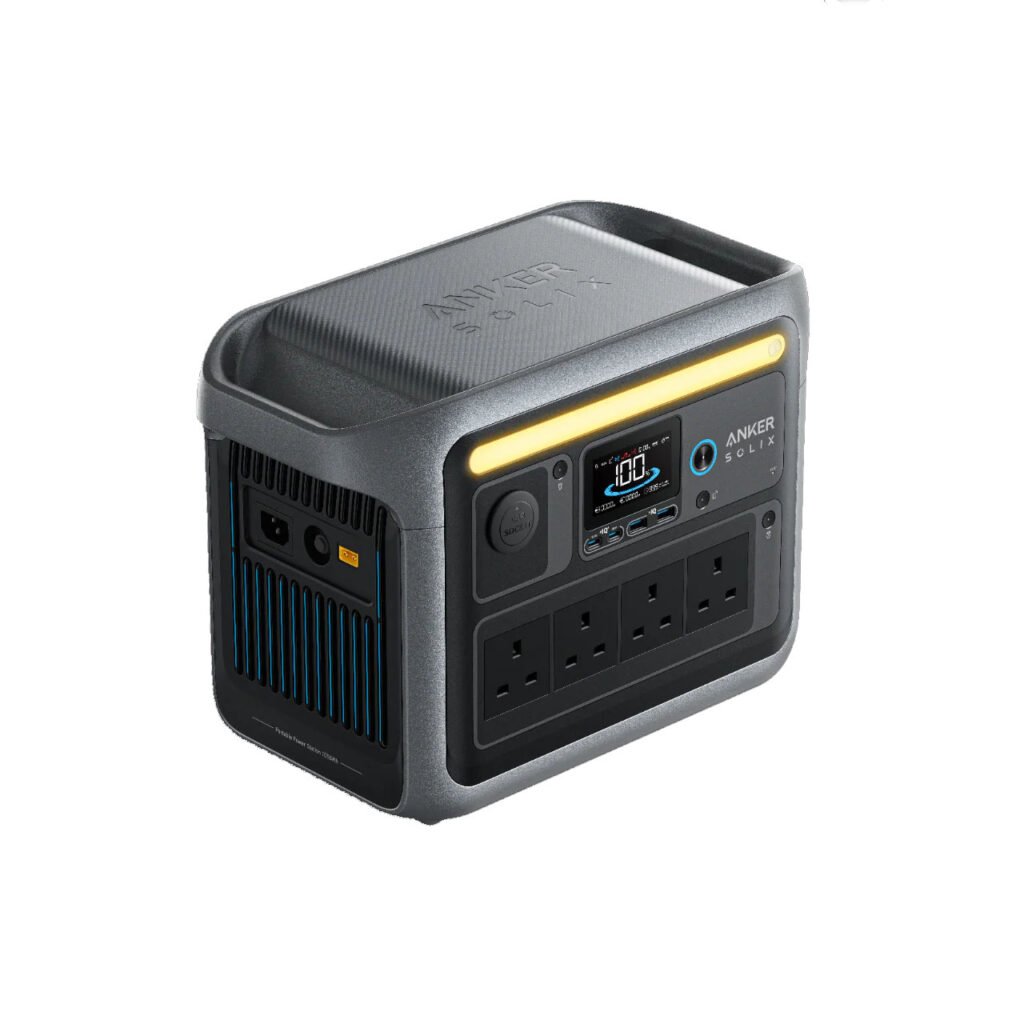
The Anker Solix C1000 at a glance
The Anker SOLIX C1000 is a portable power station ideal for camping enthusiasts, campers, and tech lovers. With a capacity of 1056 Wh and a continuous output of 1800W (up to 2400W peak), it offers enough power to power even energy-hungry devices like coffee makers or small tools. This portable, mobile energy source can supply up to nine devices simultaneously with energy from its internal LiFePO4 battery via various ports when no other power source is available or the power source fails.
Besides, this power station can be charged with up to 600W via an XT60 solar cable. Also, its capacity can be doubled to 2112 Wh with the optional BP1000 expansion battery – a feature that sets it apart from many competitors. The additional battery itself does not offer any ports and is significantly less expensive than the C1000 power station. The following sections will clarify who the C1000 is specifically worth it for and where it excels in practical use.
Technical data
| Battery capacity | 1056 Wh (LiFePO4) |
| Continuous power | 1800W (pure sine wave) |
| Top performance | 2400W (SurgePad technology) |
| Exits | 4x AC (230V), 2x USB-C (100W/30W), 2x USB-A (12W), 1x 12V car |
| Loading times | 1h (grid), 4.2h (solar), 11h (car) |
| Special features | App control, MPPT solar controller, UPS function (<20ms), expandable |
The technical specifications show that the Anker SOLIX C1000 is no lightweight, but its power density is great. With 3,000 charging cycles (up to 80% capacity) and a 5-year warranty, Anker is also committed to long-term use.
Download User Guide here
Scope of delivery & first impression
The scope of delivery of the Anker SOLIX C1000 is well thought out and includes everything necessary for immediate use:
- The power station itself (12.9 kg / 28.44 lb)
- Main charging cable
- Solar charging cable with XT60 connector
- 12V car charging cable
- User manual
The packaging is sturdy and optimally protects the device from transport damage. The compact design (38 x 20 x 26 cm) is striking. So, this is surprisingly handy for a power station of this performance class. Upon first unpacking, the high-quality appearance is impressive. The matte surface with blue accents creates a high-quality impression, and the switches and ports are precisely recessed. One critical point is that important ports such as the AC inputs remain uncovered. So, rubber caps would have been useful here.
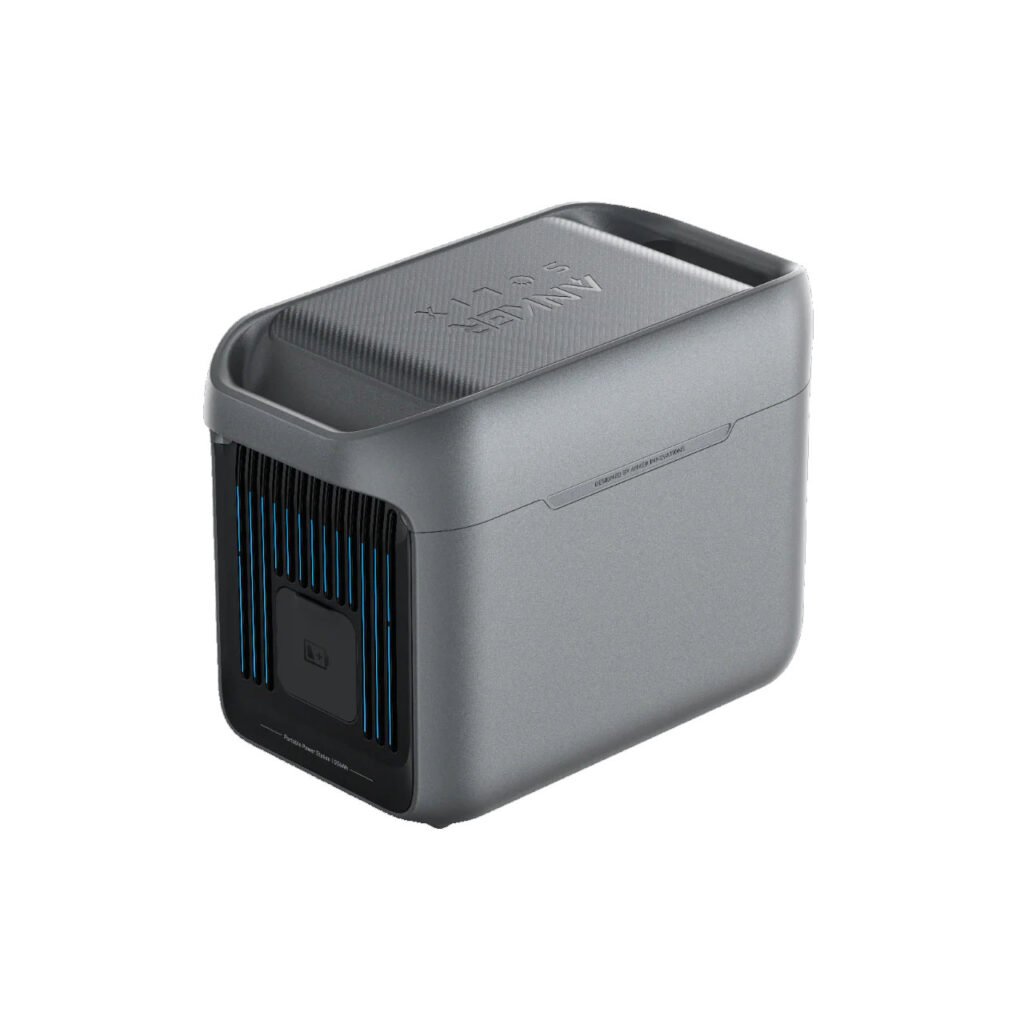
Design of the Anker Solix C1000
The C1000 power station weighs 12.9 kg (28.44 lb) and measures 376 × 205 × 267 mm (14.8×8.07×10.5 in). While comparatively compact, it’s not comfortable to carry over long distances. The flat top not only allows for easy placement of objects and devices while on the go, but also allows for the BP1000 additional battery, which doubles the battery capacity, to be stacked directly on top. The connection for the extra battery is located on the right side of the power station under a rubber cover.
With its design, Anker shows that even a power station doesn’t have to be visually boring, skillfully using blue accents to give the Solix C1000 a futuristic appearance. Also, the C1000’s build quality is impeccable.
Battery technology of the Anker Powerstation
For its battery technology, Anker relies on lithium iron phosphate ( LiFePO4 ), slightly heavier than a lithium-ion battery of the same capacity because of its lower energy density, but it offers a longer lifespan. As is typical for good LiFePO4 batteries, the Solix C1000’s energy storage system is said to retain at least 80 per cent of its capacity after 3,000 charging cycles, corresponding to a lifespan of at least ten years. The manufacturer offers a five-year warranty. The battery capacity in the C1000 is 1,056 Wh; with the additional BP1000 battery, it has a capacity of 2,112 Wh.
The connections of the Anker Solix C1000
The Anker Solix C1000 offers connections for nine devices. These are divided into four 230-volt AC outlets, two USB-A and two USB-C ports, and a car charger. The USB-C outlets deliver varying levels of power. One offers up to 100 watts, the other up to 30 watts. In practice, this is enough power to easily power a laptop via USB-C without the need for a power adapter. The USB-A outlets each deliver up to 12 watts, while the car charger output delivers the standard 120 watts (12 volts, 10 amps).
The AC outlets can provide a total of up to 1,800 watts continuously. If the Solix C1000 is used in bypass mode for uninterruptible power supply, i.e., it is simultaneously connected to the mains via the AC input, it can draw up to 2,070 watts via the AC outlets.
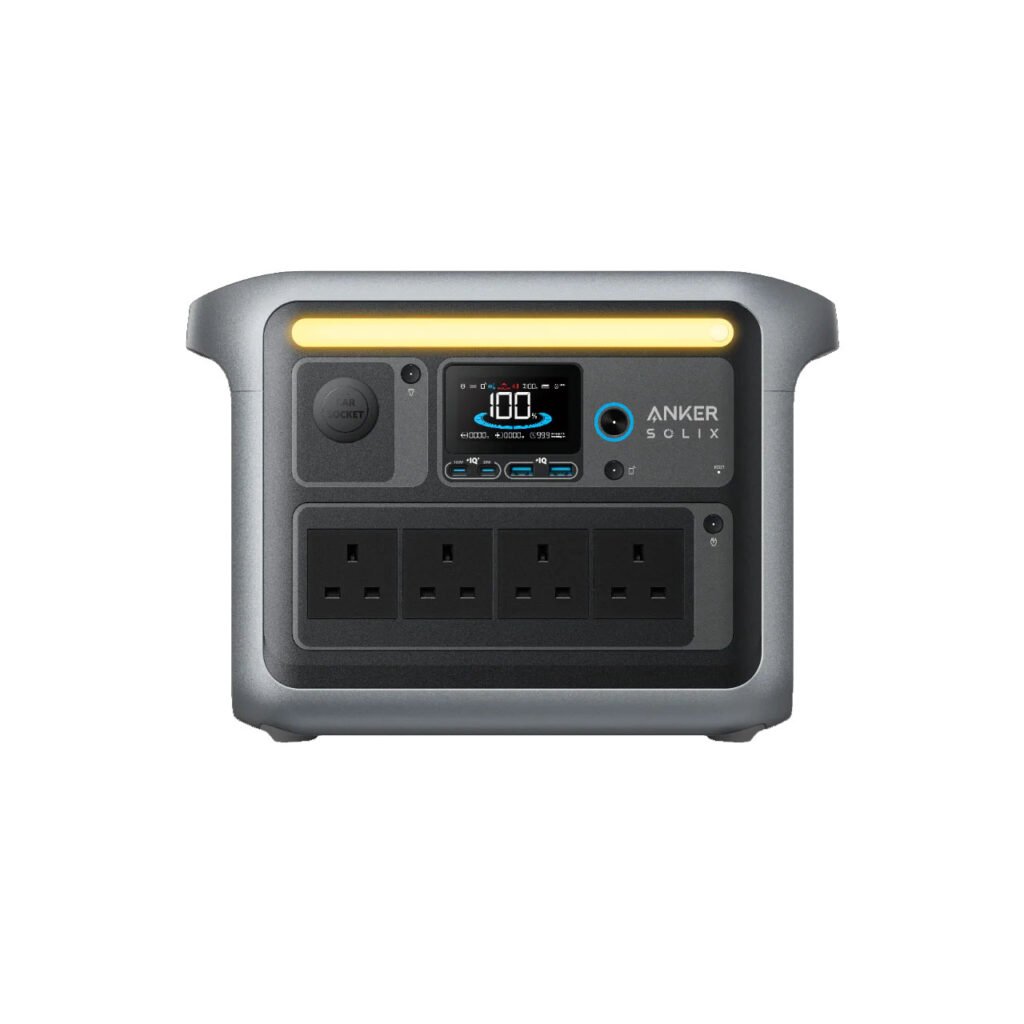
Short-term up to 2,400 watts
Up to 2,400 watts can be temporarily provided to a device via an AC outlet. Anker calls this feature SurgePad. It is automatically activated when more than 1,800 watts are required. However, it can only be used reliably with devices that represent a regulated load. For example, devices that do not require a fixed output of, say, 2,200 watts, but can also be operated at 2,000 watts. These include fan heaters, for example, which then operate at lower power.
All outputs are located on the front and, apart from the vehicle power connector, offer no protection against dirt entry. You can individually turn the AC and DC ports on and off using dedicated buttons. This means there’s no need to unplug devices when you want to stop their operation or power supply. The USB outputs, on the other hand, are always active and cannot be deactivated either on the power station or via the app.
Charging with AC or solar energy
The two inputs, the AC connector and an XT60 solar input, are located on the left side of the power station. Unlike many competitors, they are exposed and not hidden behind a flap. The Solix C1000 can be charged with up to 1,300 watts via AC and up to 600 watts via the solar input.
If a solar module with a voltage range of 11 to 32 volts is used, the maximum supported current is 10 amps. In the voltage range between 32 and 60 volts, however, the maximum supported current is 12.5 amps, with a maximum of 600 watts not to be exceeded.
It’s not possible to charge the Solix C1000 via AC and DC simultaneously. The AC input always takes priority when both the AC and DC inputs are connected. Only when the AC charging process is complete does the C1000 automatically switch to DC charging. The other way around seems to be more environmentally friendly in everyday life, at least, although the case of both being connected in parallel is rare anyway. However, if you want to use the DC input, you have to disconnect the AC input.

Display and LED lamp
Anker also equips the C1000 with a display that centrally shows the battery charge level. The current output and input power, as well as the expected remaining battery life or charging time at the current power level, are shown at the bottom. Meanwhile, the top edge displays which outputs are active. It also shows whether the power station is connected to a Wi-Fi network for remote access via the Anker app. Besides, it shows if any protection circuits have been triggered.
Anker has placed an LED strip above the display, which can be activated via a separate button on the right side. The manufacturer calls it ambient light, which is apt. The light can be adjusted to three brightness levels (1 watt, 2 watts, and 3 watts), either via the button or the app. If the button is held down, the LED light sends the SOS signal as a light signal. This can also be activated in the app, but in a separate entry in the settings and not directly in the device controls.
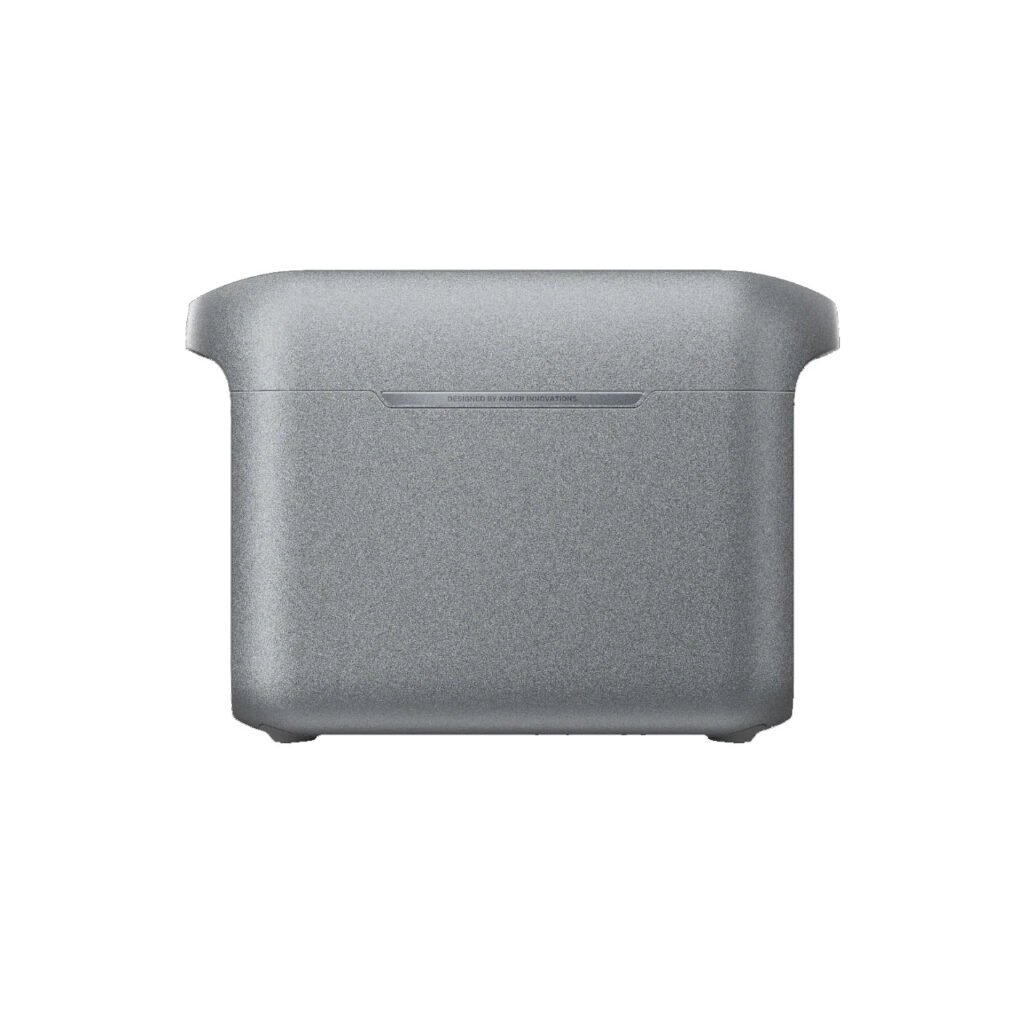
Charging with a maximum of 1,300 watts
The battery can be charged with a maximum of 1,300 watts, using the fast charging mode called “HyperFlash.” Without this mode, charging via AC is limited to 1,000 watts. To charge at 1,300 watts, the “Ultra Fast” function must be activated in the app. In the Anker app, the charging power without fast charging can also be set between 200 and 1,000 watts (200, 300, 400, 500, 600, 750, and 1,000 watts), allowing you to choose the best compromise between speed, battery life, and noise level.
According to Anker, the power station is fully charged in 58 minutes at 1,300 watts. With fast charging enabled, it even took 55 minutes. If you reduce the charging speed to 600 watts, the power station is 55 per cent charged after one hour. And fully charged after 1 hour and 55 minutes. Simultaneous charging and discharging is no problem.
The volume of the Anker Solix C1000
Volume when charging
When charging at up to 1,000 watts, the Anker Solix C1000 reaches a noise level of 44.5 dB at a distance of 30 cm from the front and 48.5 dB at a distance of 30 cm from the left side of the case. The fan’s speed fluctuates noticeably every few seconds instead of maintaining a constant speed. The internal temperature of the C1000 displayed in the Anker app during testing is 50°C.
When fast charging mode is activated, the C1000 becomes very loud. It measures 51 dB at a distance of 30 cm from the front, and even 59 dB on the left side.
The volume during discharge
Under load, i.e. when the battery is discharging, the C1000 gets even louder when you put a lot of pressure on it. When it’s loaded with 2,000 watts, the noise level is 65.5 dB at a distance of 30 cm from the front and 67.5 dB on the left side at a distance of 30 cm. The temperature of the power station is 57°C. The Anker Solix C1000 switches off at 58°C. In the test, this happened with 2 per cent battery remaining after a continuous load of 1,800 to 2,000 watts. Mind you, it’s actually only specified for a continuous load of 1,800 watts.
When the C1000 switches off, the fan also stops after a few seconds. This prevents it from continuing to cool the power station. Consequently, this delays the unit from being ready for use again more quickly. This means that the overheating protection takes an unnecessarily long time to deactivate again. It would make more sense if the manufacturer deactivated the outputs in the event of overheating. This would allow the power station to be actively and quickly cooled via the fan. Passive cooling would no longer be the sole method.
If the Solix C1000 is subjected to lower performance within its specifications, it remains quieter. However, it’s still not a silent machine. At a continuous load of 500 watts, the noise level at the front at a distance of 30 cm is 41.9 dB. And at the sides it is 42.6 dB. However, even at this level, the fan produces a clearly audible hum.
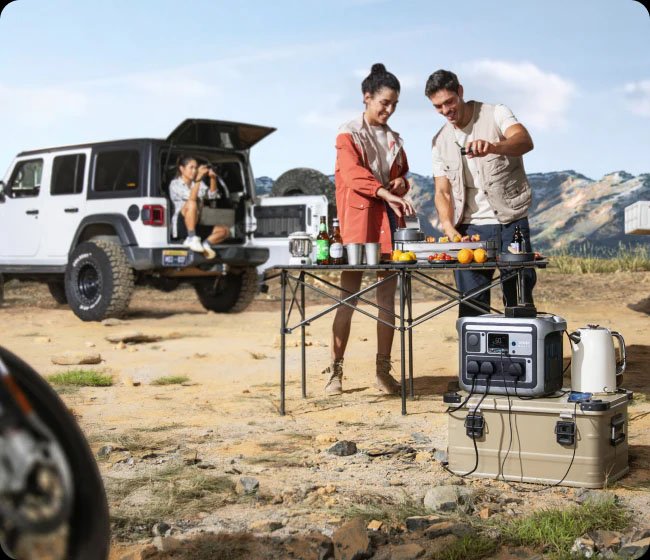
The capacity in everyday life
An interposed current meter shows the losses that occur when discharging the battery with a nominal capacity of 1,056 Wh. For this purpose, a load with different load levels is connected.
Usable energy of the Anker Solix C1000
| Continuous load | Measured capacity | Efficiency |
| 500 watts | 993 Wh | 94.0% |
| 2,000 watts | 954 Wh | 90.3% |
| Nominal capacity | 1,056 Wh | |
The measured capacity of the Solix C1000 is 993 Wh at a continuous draw of 500 watts and 954 Wh at a continuous draw of 2,000 watts. At over 90 per cent of the rated capacity, the actual available capacity is in a very good range.
Losses also occur when charging the power station. To fully charge the 1,056 Wh of the C1000, 1,147 Wh are required in the test with slow charging and 1,204 Wh with fast charging. The difference between the absorbed energy and the rated capacity is only 8.6 per cent when fast charging is not used, which also protects the battery.
The total energy loss because of charging and discharging amounts to 15.5 per cent, which is an excellent value.
Charging/discharging losses of the Anker Solix C1000
| Nominal capacity | Maximum energy extracted | Energy required for charging | Loss |
| 1,056 Wh | 993 Wh | 1,147 Wh | 15.5% |
Overload protection: 2,000 watts are also supplied
Designed for a continuous load of 1,800 watts, 2,000 watts proved no problem. At 2,500 watts, the overload protection triggers reliably but also immediately.
No shutdown for unregulated loads
The Anker Solix C1000 had no problem with unregulated loads with high inrush current, which other power stations in the test field had already failed under, and their overload protection had triggered. The high-pressure pump with compressor, which was now also used in the tests, also started up without any problems. The Ugreen PowerRoam G1200 (test), for example, couldn’t manage this, even though the dehumidifier with high inrush current, which was also used in the test, started up without any problems.
Uninterruptible power supply
The Anker Solix C1000 can also be used as an uninterruptible power supply (UPS). The manufacturer claims it transitions from bypass mode in less than 20 ms and supplies connected devices from the battery before shutting down. To do this, the C1000 is connected to the mains, and the power device is powered from an AC outlet on the power station. Up to 2,070 watts of power are available. In a power outage, the power station switches to its internal battery and supplies the device before shutting down.
The C1000 is tested in two scenarios. First, a PC is used under load, consuming approximately 500 watts, and a power outage is simulated via the fuse. The C1000 switches over quickly enough, and the PC continues to run without interruption. In the second scenario, a NAS with four drives is connected to the power station, which serves as a UPS. In this case, switching the power source is also not a problem, and the NAS survives the simulated power outage without any problems.
BUYOperating times & application examples of the Anker SOLIX C1000
Practical runtime tests with typical end devices: Here’s an overview of the measured operating times with a full battery charge (1,056 Wh):
| Laptop (50W) | Approx. 18 hours |
| Smartphone (10W) | Over 100 charges |
| LED camping lamp (15W) | Approx. 60 hours |
| Cooler (60W) | Approx. 15 hours |
| Coffee machine (1,000W) | Approx. 50 minutes |
| Power tool (800W) | Approx. 1 hour 15 minutes |
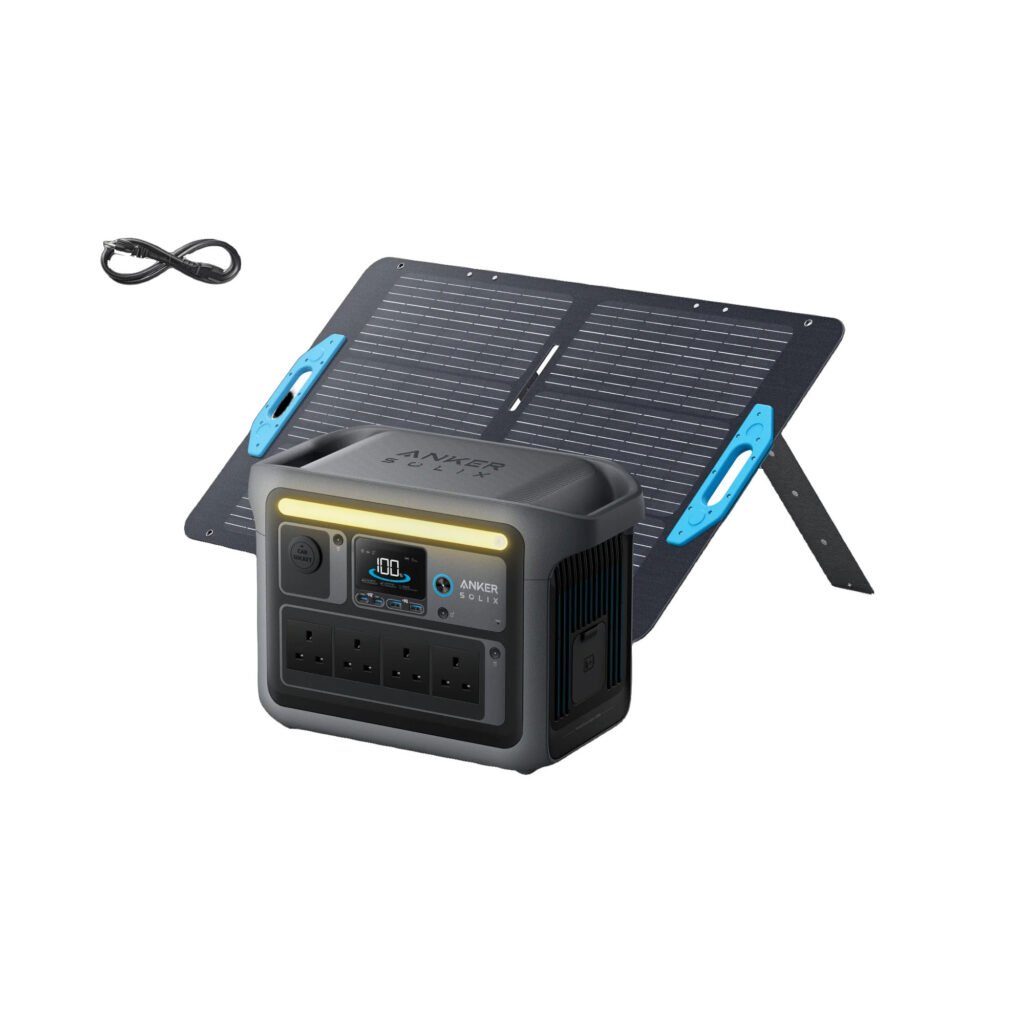
Anker app for control
The C1000 can be connected to the user’s Wi-Fi network, allowing remote control and monitoring of battery levels via the Anker app. A local Bluetooth connection is also possible, for example, if Wi-Fi is unavailable.
The app not only displays the battery level and current temperature, but also the current charging and discharging power, as well as the expected remaining runtime. Just like the device, the app can control the outputs to turn off connected devices at any time—USB cannot be disabled here either. It is also possible to configure the aforementioned functions, such as fast charging mode, AC charging power, automatic shutdown of the power station, LED light, screen brightness, and screen timeout, as well as perform firmware updates, in the app.
What isn’t possible, however, is manually configuring charge and discharge limits. For example, to only discharge the battery to a maximum of 10 per cent of its remaining capacity and charge it to 90 per cent of its capacity to conserve battery life when the full amount of energy isn’t needed. When discharging, the C1000 deactivates the AC outputs at a remaining charge of 1 per cent, so that it isn’t completely drained and can still be accessed via the app, for example. If the battery is running low, the user is also alerted via notifications so that they can intervene in time if necessary.
Advantages and Disadvantages of the Anker Solix C1000 Power Station
What we like
What we don’t like
Conclusion
The Anker SOLIX C1000 is a powerful all-around power station for camping, emergency power, and mobile work. Its high continuous output of 1,800W and fast charging capabilities set it apart from many competing models.
This power station is ideal for campers, digital nomads, craftsmen, and households with emergency power needs. However, it is less suitable for ultralight travellers (13 kg), users who need absolute silence. The price-performance ratio is very good considering the robust construction and 5-year warranty. So, this product is perfect for users who require high performance and expandability. The combination of power, fast



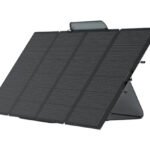
Leave a Reply